Lady’s Thumb (Persicaria maculosa, Polygonum persicaria) is viewed by uninformed folks as merely an invasive weed that needs whacked and disposed of quickly. But, to homesteaders and fans of wild edibles in general, discovering this plant on your land can provide a natural bounty of home remedy ingredients.
This annual wild plant is a part of the buckwheat – smartweed family. Lady’s Thumb (Persicaria maculosa) is also commonly referred to by common names such as Redshank, Pennsylvania smartweed, and Spotted Lady’s Thumb.
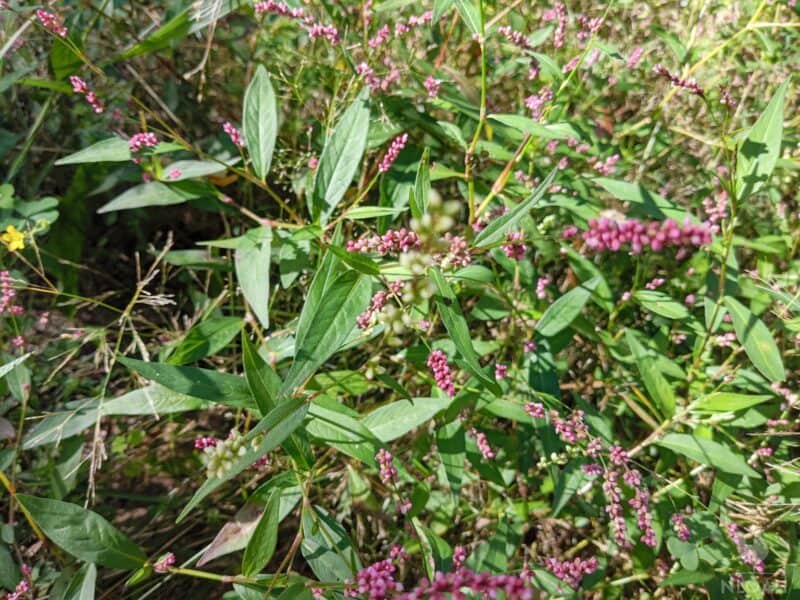
It came to the United States from Eurasia during the middle of the 1800s era. Since it was first spotted along the Great Lakes, Lady’s Thumb has spread throughout the continent of North America.
Quick Facts
| USDA hardiness zones | 2 through 10 |
| habitat | backyards, roadside, damp areas |
| soil | clay, sandy, gravel |
| location | roads, tunnels, ravines, concrete canals |
| lighting | partial shade to full sun |
| edible parts | leaves, stem, flowers, seeds |
| height | 1 – 2.5 feet / 20 to 80 cm |
Is Lady’s Thumb Edible Or Poisonous?
Every part of the Lady’s Thumb plant is edible. It is best consumed from the middle of spring through the late fall.
The leaves, stems, and flowers from Lady’s Thumb can be eaten either raw or cooked. This wild edible has a taste that resembles lettuce.
The seeds from young plants are also edible. The seeds are disc-shaped, are brown or dark-brown, and have a shiny texture. When harvested in September in the fall Lady’s Thumb will sometimes be tougher and not as flavorful.
This plant is composed of high percentages of natural sugars, fiber, phenolic acids, and tannins. Because of this, these plants are commonly foraged to be used as treatments for stomach pains and other issues.
There are numerous varieties of plants in the Persicaria family. While the term smartweed has been tossed about to describe all of them, it has a slightly hotter flavor that is immediately noticeable.
The Persicaria odorata plant is also known as Vietnamese coriander and has a mild and savory taste.
Lady’s Thumb Safety Concerns
- Although Lady’s Thumb has not been known to cause photosensitivity in humans, some Polygonum plant species do have such an effect.
- It does contain oxalic acid (like rhubarb) and could cause health issues if eaten in significant quantities.
Is Lady’s Thumb Invasive?
This summer annual broadleaf plant is reproduced by the broadcasting of its seeds, which allows it to spread quickly – hence the plant has sometimes been deemed invasive.
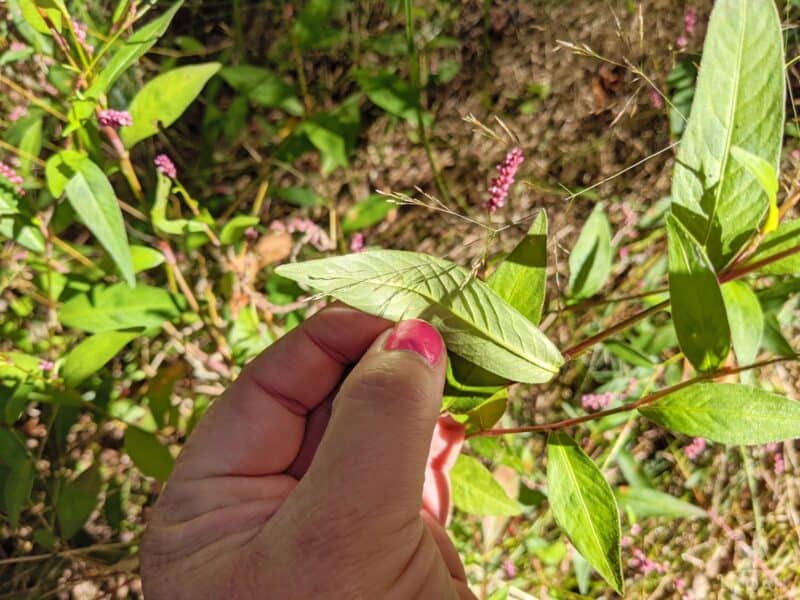
Lady’s Thumb Identification
- Look for plants that are anywhere between 8 inches and 30 inches in height (between 20 cm and 80 cm), but you can sometimes spot plants that are 3 feet tall!
- Most of the tall height of the Smartweed plant comes from the slender pink flower stems. The sepals of the flowers are usually pink but can also be purple, red, greenish-white, and other shades. One plant can have multiple flower colors on the same stalk!
- Flowers are between half-an-inch to two-inch clusters of pink oval shape on a pink spike. Each individual flower oval is roughly one-eighth of an inch long.
- Leaves on the Lady’s Thumb plant range in size from two inches to six inches long. They are green lance-shaped leaves with a “smudge mark” usually in the shape of an oval or distorted triangle in a dark green shade in the center.
- The leaves on this wild plant alternate up the stem, one per node.
- Leaves are narrow and elliptic. They commonly grow between four to six inches long.
- The underside of each leaf typically feels rough to the touch, and has little bumps – but no hair.
- The membranes on the nodes have a papery type feel and are covered with tiny and slanting hairs that measure up to 2 millimeters long.
- Seeds have three nodes.
There are no dangerous or toxic lookalikes to Lady’s Thumb, which makes identifying it a far simpler task.
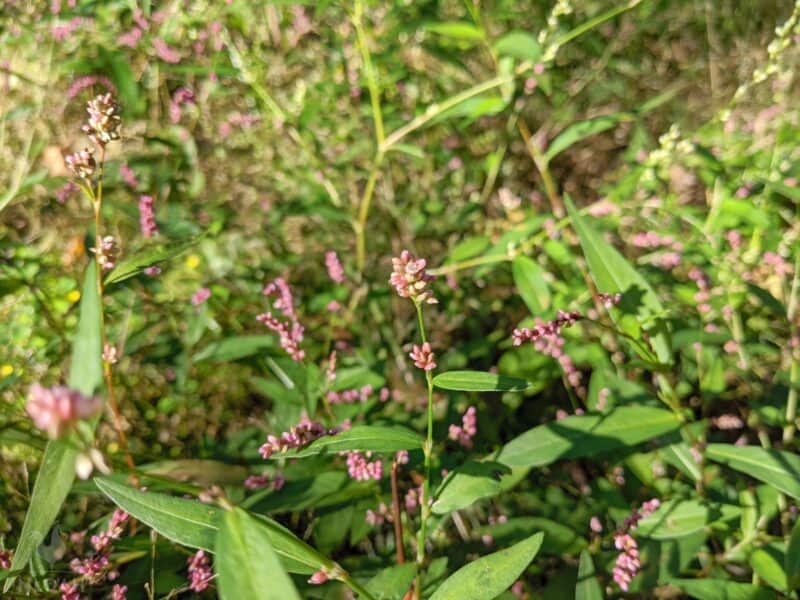
But, you should never consume or use even topically any plant that you have are not 100% sure of its origins – and that it has not been sprayed with weed-killing chemicals.
Types of Lady’s Thumb
There are a few types of lady’s thumb to be aware of, all of which belong to the same genus and can be found growing invasively in the United States.
Nodding Smartweed (Persicaria lapathifolia)
Nodding smartweed is native to North America and can be found growing in moist soils near streams, ponds, and rivers. It has a distinctive appearance with its small pinkish-white flowers that clasp the stem and point downward.
Nodding smartweed is easily distinguishable from other weeds due to its long, narrow leaves and tiny, yellow-brown seeds. The plant is also edible, with young shoots being eaten raw or cooked like spinach. It is also rich in iron, magnesium, calcium, vitamin C, and potassium.
Pennsylvania Smartweed (Persicaria pensylvanica)
This plant is native to the eastern United States but can be found growing in other parts of the country as well. Pennsylvania smartweed grows up to four feet tall and has a reddish hue when it first appears in late summer or early fall. Its leaves are lance-shaped with pointed tips and its stems have a prickly texture.
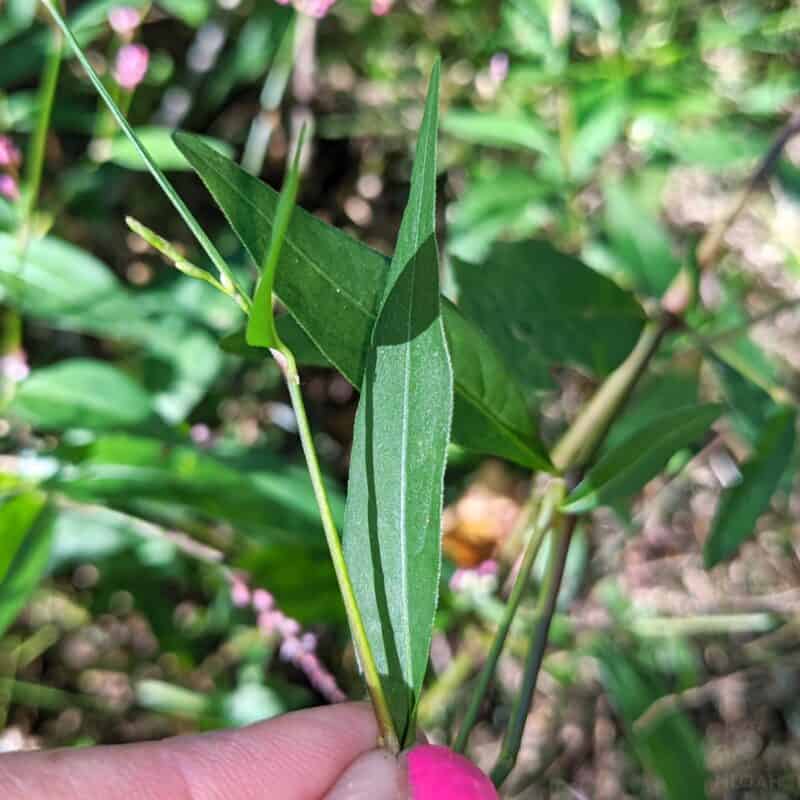
Like nodding smartweed, Pennsylvania smartweed is edible with young shoots being eaten raw or cooked like spinach. It contains high levels of vitamins A and C as well as fiber, calcium, iron, magnesium, potassium, zinc, copper, manganese, and selenium.
Oriental Lady’s Thumb
There is another type of lady’s thumb to be aware of – oriental lady’s thumb.
Identifying this plant is more or less the same as identifying other types of lady’s thumb plants. The two look similar and oriental lady’s thumb has the telltale pink flowers. However, they are generally more pronounced.
There are also long bristles in the flower clusters of oriental lady’s thumb (which is known as P. longisetum instead of P. maculosa). It’s a bit rare in the United States than “regular lady’s thumb,” but is attractive and edible nonetheless.
Lady’s Thumb Medicinal Uses
Lady’s Thumb has been used in herbal healing remedies by Native Americans for hundreds of years. Lady’s Thumb has been used to treat not only human ailments but livestock ones as well.
The potential antibacterial, anti-fungal, and anti-inflammatory properties of the leaves and flowers make it excellent to use topically. This wild edible and medicinal plant has been used to treat a vast array of ailments and injuries, often in poultice form.
Drying leaves to use in a natural healing tea allows fans of this hardy to consume it for not only its nutritional components but to treat internal woes, as well.
- Insect Stings
- Poison Ivy
- Insect Repellent – crunched leaves rubbed onto livestock and skin
- Rheumatic Pain
- As a blood stopper
- Stomach pain (as a tea)
What Animals Are Attracted To Lady’s Thumb?
- Honeybees and halictid bees
- Birds
- White-tailed deer (mammalian herbivores may find the foliage too bitter during certain times of the year, though not always)
- Wasps and syrphid flies
- Grasshoppers
- Granivorous songbirds
- The larvae of several moths and the larvae of sawflies
Where Does Lady’s Thumb Grow?
In the United States Lady’s Thumb and other varieties of Smartweed can be found in USDA Growing Zones 2 through 10. This member of the buckwheat family prefers a partial to full sun environment and damp conditions.
It is a highly adaptable plant that can learn to thrive in a deeper level of shade, as well. It is often found along the edge of the woods near a ravine, stream, or pond.
Suburban and urban homesteaders can likely find some Lady’s Thumb plants growing along the edges of vacant lots, alongside railroad ties, near concrete canals, and in places that have been dismissed as wastelands.
Lady’s Thumb is not picky about soil quality. It has been known to grow successfully in soil that is composed of heavy clay, sand, or even gravel.
Once the many seeds housed inside of the small flowers are dispersed by wind and germinate, new plants start growing rapidly and may bloom when they are merely several inches tall. Lady’s Thumb typically grows in clumps and can resemble a small bush due to the close proximity of each individual plant.
Harvesting Lady’s Thumb
Above-ground parts of the plant can be snipped or tugged free any time during the year to use as either a wild edible or a natural healing ingredient – or as part of a cold-pressed soap recipe.
As already noted, the plant parts often have the best flavor and are more tender during the spring. Greens are best harvested from the spring through October before they start to get incredibly tough, and wilt, and could start to grow moldy as the temperature dips deeply during the night.
If you want to shake seeds away from a plant to cultivate your own crops, this should be done when the annual is “going to seed” from late August through October.
Resist the urge to harvest the seeds too early. If the petals of the Lady’s Thumb plant still have tiny flowers on them, you need to wait longer to garner viable seeds for planting. During this growth stage, the seeds tend to look green or tan.
If no flowers are still visible or only a few exist and easily chaff off when rubbed, the seeds should be ready to harvest. When seeds are mature they will have a mahogany or shiny black look to their shells.
Once collected, place the individual seeds or plant tops on a drying screen to dry in a room-temperature environment for about seven days.
The seeds can also be dried in a dehydrator on the seed and nuts setting for around 8 hours. Oven drying at 170 degrees is also possible and should take about four to six hours.
No matter what manner you choose to dry seeds, make sure they are spread out on a tray or baking sheet so they do not touch.
Lady’s Thumb is a favorite wild edible on our homestead. Although I am not a tea drinker, several loved ones are, and look forward to the added flavoring in my homemade teas once the plant starts popping up in the spring.
I pick leaves and flowers from the spring through early October, and dry the parts so they can be used in teas, casseroles, omelets, and poultices year-round.
How To Eat Lady’s Thumb
- The raw uncooked leaves can be used as a lettuce substitute.
- Raw leaves and flowers can be dried and brewed into tea.
- Sautee leaves and chopped stem parts, and use them as a part of a foraged stir fry dish.
- Seeds can be eaten raw, roasted, cooked, or sautéed.
One of my favorite ways to eat Lady’s Thumb is as a breakfast food. I boil the leaves for about 10 minutes and then combine them with bacon and eggs to make an omelet.
Some folks love boiled leaves mixed with garlic and butter as either a side dish to a meal or as a flavoring in stews, soups, casseroles, or as part of a marinade for meat dishes.
Whichever type of these small flowers you choose to forage for, know that there are many uses for these annual plants. Some folks into homemade dyes use it to get a bright yellow color.
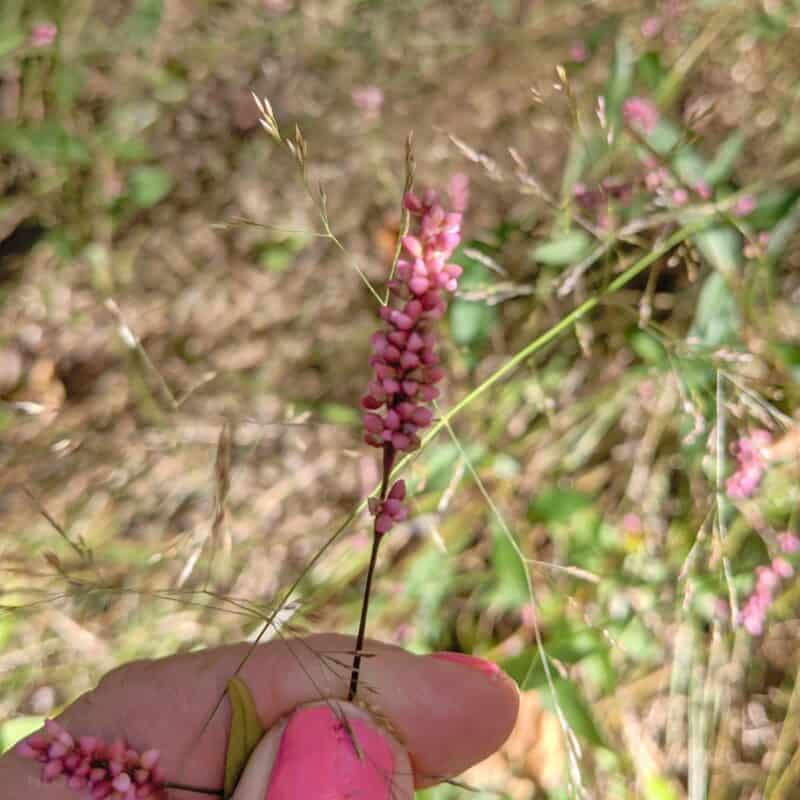
Disclaimer
I am not a medical professional of any type. The possible natural healing benefits and uses of Lady’s Thumb are offered purely for entertainment and research purposes. Always consult your doctor before foraging wild edibles or making natural remedies.
Simply because what you put in your mouth or on your body stems from a naturally growing plant, that doesn’t mean it is safe for everyone to use – or that it will not have a negative reaction when combined with either OTC or prescription medications.
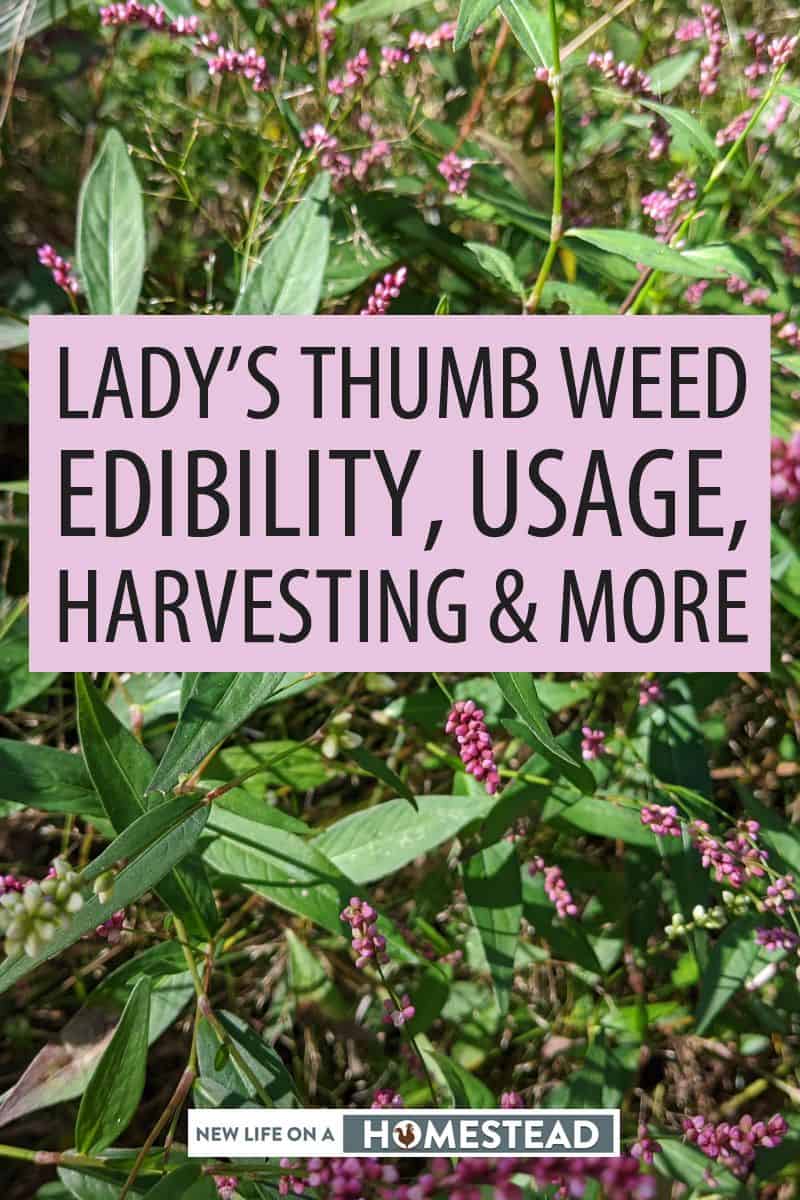

Tara lives on a 56 acres farm in the Appalachian Mountains, where she faces homesteading and farming challenges every single day, raising chickens, goats, horses, and tons of vegetables. She’s an expert in all sorts of homesteading skills such as hide tanning, doll making, tree tapping, and many more.

Hi I’m sure this is growing wild in my grass, and it’s ruining my lawn , now so I get rid of it ?I’m in England.
Someone had mentioned to me it makes for pretty foliage for arrangements as well. Just another suggestion if someone reading happens to grow flowers.
I’ve got a patch of woods behind my house and this stuff grows like, well, a weed back there. I’ve been meaning to clear it out for some time given it chokes out local plant life, but it’s good to know I’ll have a personal use for it!
Thanks for sharing this info. I have some growing in our yard and was wondering what it is.
I have plenty here(central Labrador, Canada) that came in a bag of fall rye I bought from somewhere in Nova Scotia to be used as a plow-down green manure…..now I have uses for it other than exercise pulling it out!!